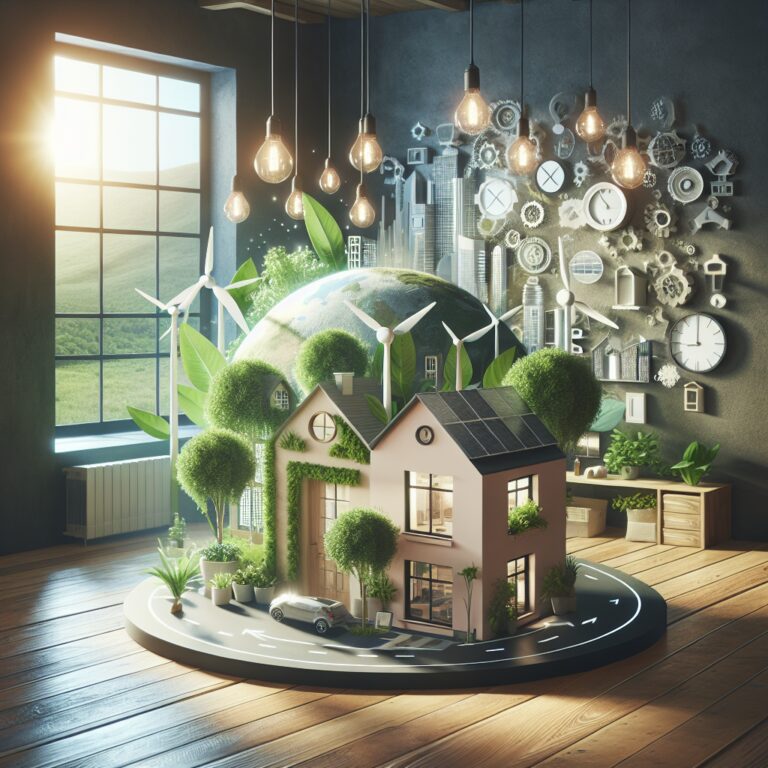The homes we build today shape the planet we’ll inhabit tomorrow. As climate challenges intensify and energy costs soar, green homes have evolved from eco-enthusiast dreams to mainstream necessity. Standing in a modern sustainable home feels different—the air is fresher, the spaces more thoughtfully designed, the connection to nature more intentional. Yet beyond these immediate comforts lies a profound shift in how we understand residential living. Green homes represent not just buildings with smaller carbon footprints, but a fundamental reimagining of how we can live in harmony with our environment while creating spaces that nurture our wellbeing and financial security.
*Sustainable living isn’t just an environmental choice—it’s becoming the smartest financial and lifestyle decision for homeowners.*I remember the moment I first walked into a “green home” – the abundance of natural light, the noticeably fresher air, and that sense of being in a space designed to work with nature rather than against it. It wasn’t just a house; it felt like a glimpse into what our future homes could and should be.
*Beyond eco-friendly features, tomorrow’s green homes will transform how we live, combining sustainability with technology to create healthier, more efficient living spaces that benefit both people and planet.*
The Evolution of Green Housing
The concept of environmentally conscious housing has evolved dramatically over the past few decades. What started as simple energy-efficient appliances and better insulation has transformed into a comprehensive approach to sustainable living. Green homes have progressed from niche eco-experiments to mainstream housing solutions that address our most pressing environmental challenges while enhancing quality of life.
Today’s green homes incorporate renewable energy systems, water conservation technologies, sustainable materials, and designs that maximize natural resources. But the future promises even more innovative approaches that will fundamentally change our relationship with our living spaces.
From Passive Design to Active Generation
The earliest green homes focused primarily on passive design principles—orientation to capture natural light, thermal mass to regulate temperature, and strategic ventilation. While these fundamentals remain important, tomorrow’s green homes are becoming increasingly active participants in our energy ecosystem.
Modern green homes don’t just consume less energy; they produce their own. The shift from energy-efficient homes to energy-generating homes represents a pivotal evolution in sustainable housing. Solar panels, once considered a luxury addition, are becoming standard features, with newer models integrated seamlessly into roofing materials and even window surfaces.
Core Technologies Shaping Green Homes
The green homes of the future will leverage multiple technologies working in harmony to create truly sustainable living environments. Understanding these core technologies helps us appreciate how comprehensive the green approach has become.
Integrated Renewable Energy Systems
Future green homes will feature fully integrated renewable energy systems that go beyond today’s rooftop solar panels. These homes will incorporate:
- Building-integrated photovoltaics that replace conventional building materials in parts of the building envelope
- Small-scale wind turbines designed specifically for residential use
- Geothermal heat pumps that leverage the earth’s constant underground temperature
- Advanced energy storage solutions that maintain power supply during outages and optimize energy use
The combination of these technologies will allow homes to not only meet their own energy needs but potentially contribute excess energy back to the grid, transforming our neighborhoods into decentralized power generation networks.
Smart Home Technology for Sustainability
The intersection of sustainability and smart technology is creating homes that actively manage resource use. Smart systems move beyond convenience to orchestrate a home’s functions for maximum efficiency while adapting to occupants’ habits and preferences.
Future green homes will feature AI-powered systems that predict and adjust heating, cooling, and lighting needs based on weather forecasts, occupancy patterns, and time of day. Imagine windows that automatically tint during peak sunlight hours or irrigation systems that adjust watering schedules based on soil moisture readings and weather patterns.
Smart water systems will detect leaks instantly, monitor usage patterns, and even recirculate graywater for appropriate uses. The data collected by these systems will provide homeowners with detailed insights into their resource consumption, empowering more conscious decisions about usage.
Building Materials Revolution
The materials we use to build our homes are undergoing a profound transformation that will redefine what green construction means in the coming decades.
Sustainable and Regenerative Materials
Future green homes will increasingly be built with materials that generate minimal environmental impact or actually benefit ecosystems. These include:
- Engineered timber products that sequester carbon while providing structural integrity
- Mycelium-based insulation grown from fungal networks
- Self-healing concrete that reduces maintenance and extends building lifespan
- Recycled and upcycled materials that divert waste from landfills
Perhaps most exciting are developments in living building materials—composites that incorporate biological organisms to achieve remarkable properties like self-repair, air purification, and responsive behavior to environmental conditions.
Performance-Optimized Design
Advanced modeling and simulation tools are enabling architects to design homes that respond perfectly to their specific location and climate. This computational approach to design optimizes everything from window placement to wall thickness based on detailed environmental data.
The result is homes tailored to their precise setting—a house in Arizona will have fundamentally different design features than one in Maine, even if both achieve net-zero energy status. This site-specific optimization represents a return to regionally appropriate building, enhanced by modern technology.
Health and Wellbeing Considerations
Tomorrow’s green homes recognize that sustainability includes human health. The spaces we inhabit profoundly affect our physical and mental wellbeing, making health-conscious design a key component of truly sustainable housing.
Indoor Environmental Quality
Future green homes will address indoor air quality more comprehensively than ever before. Advanced ventilation systems will constantly monitor air quality parameters and adjust filtration and fresh air intake accordingly. Materials will be selected not just for their environmental credentials but also for their zero-emission properties, eliminating volatile organic compounds and other harmful substances.
Biophilic design principles—incorporating natural elements, materials, and views into built environments—will become standard practice rather than luxury additions. These connections to nature have been shown to reduce stress, improve cognitive function, and enhance overall wellbeing.
Adaptability and Resilience
As climate change creates more extreme weather events, resilience is becoming a critical aspect of green home design. Future homes will incorporate features like:
- Water collection and storage systems to manage both drought and flooding
- Structural reinforcements to withstand severe storms
- Passive cooling strategies to maintain comfortable temperatures during power outages
- Microgrids and energy storage to maintain critical functions during grid failures
These resilience features ensure that green homes don’t just reduce environmental impact but also protect their inhabitants from the impacts of a changing climate.
Making the Transition: Practical Considerations
The future of green homes isn’t just about new construction. Transforming our existing housing stock is equally important for reducing overall environmental impact.
Retrofitting Existing Homes
Most of the homes that will exist in 2050 have already been built, making retrofitting a crucial strategy. Deep energy retrofits can reduce a home’s energy consumption by 50% or more, through upgrades to insulation, windows, HVAC systems, and appliances.
Phased approaches to retrofitting allow homeowners to spread investments over time while following a comprehensive plan. Starting with an energy audit can identify the most cost-effective upgrades for immediate implementation, with more substantial renovations scheduled for natural replacement cycles.
Economic Considerations
The economics of green homes are increasingly favorable as technology costs decline and energy prices rise. While some green features require higher upfront investment, they typically offer attractive returns through:
- Reduced utility bills over the life of the home
- Increased property values and marketability
- Improved durability and reduced maintenance costs
- Tax incentives and rebates from government programs
Financial innovations like green mortgages and property-assessed clean energy financing are making these investments more accessible by allowing homeowners to pay for improvements through long-term financing mechanisms.
The Path Forward
The future of green homes isn’t just a technological evolution—it represents a fundamental shift in how we think about our living spaces. Tomorrow’s homes will be active contributors to environmental solutions rather than passive consumers of resources.
As these technologies and approaches become more mainstream, we’ll see neighborhoods transformed into interconnected ecosystems that generate clean energy, manage water resources efficiently, and create healthier environments for residents.
The most exciting aspect of this evolution is that it doesn’t require sacrifice—green homes of the future will be more comfortable, healthier, more resilient, and ultimately more desirable than conventional alternatives. By embracing these innovations, we can create living spaces that nurture both people and planet for generations to come.The homes of tomorrow are calling—and they promise a future where comfort, savings, and sustainability coexist harmoniously. As we’ve explored, green living is no longer confined to architectural sketches; it’s a tangible reality transforming ceilings, walls, and facades into dynamic partners in planetary stewardship. From energy-efficient systems that slash utility bills to materials like bamboo and recycled steel that redefine construction norms, every choice we make in our living spaces ripples outward.
Consider how simple shifts—upgrading insulation, embracing holistic design, or investing in solar-integrated facades—can yield lasting benefits for both your wallet and well-being. The journey toward sustainable living isn’t about perfection but progress: each step creates healthier homes and a more resilient world.
Ready to build your legacy?
The future of housing is bright, sustainable, and within reach. Your next move could redefine what home means—for you and generations to come. Let’s build it together. 🌿💡




